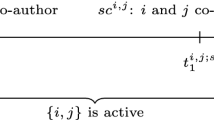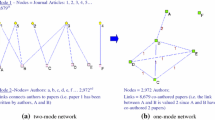Abstract
This paper aims to analyze the academic backgrounds of 3587 researchers who published in the top five economics journals in the last 10 years. We find that the researchers come from relatively diverse backgrounds at the undergraduate level, but their PhD degree-granting institutions are more concentrated. Most researchers work in a few prestigious institutions after their graduation. Therefore, co-worker relations among researchers are quite common. Many co-authors who are unrelated at the time of publication were co-workers in the past. Co-worker networks are found to be much denser than co-author networks.


Similar content being viewed by others
Notes
For example, according to the 2017 Shanghai rankings, nine of the top ten institutions in economics are from the USA. (www.shanghairanking.com/Shanghairanking-Subject-Rankings-2017/economics.html).
Because some researchers record more than one undergraduate field in their CVs, some researchers are counted more than once. If a field is recorded as secondary (e.g. minor), we did not take it into account.
Rankings are obtained from <www.usnews.com/best-graduate-schools/top-humanities-schools/economics-rankings>.
Because of lack of data, we only record years for start and end date of a career stage. For example, a researcher who has spent 2005 to 2008 in an institution is considered to have spent 3 years. This is a fair assumption because most academic jobs start and end in September.
Only 46 articles have five or six authors, so we choose to exclude them from the table.
References
Abbasi, A., Hossain, L., Uddin, S., & Rasmussen, K. J. R. (2011). Evolutionary dynamics of scientific collaboration networks: Multi-levels and cross-time analysis. Scientometrics,89(2), 687–710.
Abt, H. A. (2007). The frequencies of multinational papers in various sciences. Scientometrics,72(1), 105–115.
Adams, J. (2012). The rise of research networks. Nature,490(7420), 335–336.
Albarran, P., Carrasco, R., & Ruiz-Castillo, J. (2017). Geographic mobility and research productivity in a selection of top world economics departments. Scientometrics,111(1), 241–265.
Amir, R., & Knauff, M. (2008). Ranking economics departments worldwide on the basis of Ph.D. placement. The Review of Economics and Statistics,90(1), 185–190.
Andrikopoulos, A., Samitas, A., & Kostaris, K. (2016). Four decades of the journal of econometrics: Coauthorship patterns and networks. Journal of Econometrics,195(1), 23–32.
Andrikopoulos, A., & Trichas, G. (2018). Publication patterns and coauthorship in the journal of corporate finance. Journal of Corporate Finance,51, 98–108.
Bairam, E. I. (1994). Institutional affiliation of contributors to top economic journals, 1985–1990. Journal of Economic Literature,32(2), 674–679.
Bozeman, B., & Corley, E. (2004). Scientists’ collaboration strategies: Implications for scientific and technical human capital. Research Policy,33(4), 599–616.
Canibano, C., Otamendi, J., & Andujar, I. (2008). Measuring and assessing researcher mobility from CV analysis: The case of the Ramon y Cajal programme in Spain. Research Evaluation,17(1), 17–31.
Card, D., & DellaVigna, S. (2013). Nine facts about top journals in economics. Journal of Economic Literature,51(1), 144–161.
Colussi, T. (2018). Social ties in academica: A friend is a treasure. Review of Economics and Statistics,100(1), 45–50.
Daly, R., Machung, A., & Gina, R. (2006). Running to stay in place: The stability of ‘‘U.S. News’’ ranking system. Paper presented at the annual forum of the association of institutional research.
Ductor, L., Fafchamps, M., Goyal, S., & Van der Leij, M. J. (2014). Social networks and research output. The Review of Economics and Statistics,96(5), 936–948.
Fatt, C. K., Ujum, E. A., & Ratnavelu, K. (2010). The structure of collaboration in the journal of finance. Scientometrics,85(3), 849–860.
Fernandez-Zubieta, A., Geuna, A., & Lawson, C. (2016). Productivity pay-offs from academic mobility: Should I stay or should I go? Industrial and Corporate Change,25(1), 91–114.
Glanzel, W., & Abdulhayoglu, M. A. (2018). Garfield number: On some characteristics of Eugene Garfield’s first and second order co-authorship networks. Scientometrics,114(2), 533–544.
Goyal, S., Van der Leij, M. J., & Moraga-Gonzalez, J. L. (2006). Economics: An emerging small world. Journal of Political Economy,114(2), 403–412.
Hamermesh, D. S. (2013). Six decades of top economics publishing: Who and how? Journal of Economic Literature,51(1), 162–172.
Hoekman, J., Frenken, K., & Tijssen, R. J. W. (2010). Research collaboration at a distance: Changing spatial patterns of scientific collaboration within Europe. Research Policy,39(5), 662–673.
Ioannidis, J. P. A. (2004). Global estimates of high-level brain drain and deficit. Faseb Journal,18(9), 936–939.
Jackson, M. O. (2010). Social and economic networks. Princeton: Princeton University Press.
Jeong, S., Choi, J. Y., & Kim, J. (2011). The determinants of research collaboration modes: Exploring the effects of research and researcher characteristics on co-authorship. Scientometrics,89(3), 967–983.
Kato, M., & Ando, A. (2017). National ties of international scientific collaboration and researcher mobility found in Nature and Science. Scientometrics,110(2), 673–694.
Kim, E. H., Morse, A., & Zingales, L. (2009). Are elite universities losing their competitive edge? Journal of Financial Economics,93(3), 353–381.
Liner, G. H., & Sewell, E. (2009). Research requirements for promotion and tenure at PhD granting departments of economics. Applied Economics Letters,16(8), 765–768.
Lorigo, L., & Pellacini, F. (2007). Frequency and structure of long distance scholarly collaborations in physics community. Journal of the American Society for Information Science and Technology,58(10), 1497–1502.
Moore, W. J. (1972). The relative quality of economics journals: A suggested rating system. Economic Inquiry,10(2), 156–169.
Pepe, A., & Rodriguez, M. A. (2010). Collaboration in sensor network research: An in-depth longitudinal analysis of assortative mixing patterns. Scientometrics,84(3), 687–701.
Stephan, P. E., & Levin, S. G. (2001). Exceptional contributions to US science by the foreign-born and foreign-educated. Population Research and Policy Review,20(1), 57–79.
Sutter, M., & Kocher, M. (2004). Patterns of co-authorship among economics departments in the USA. Applied Economics,36(4), 327–333.
Woolley, R., & Turpin, T. (2009). CV analysis as a complementary methodological approach: Investigating mobility of Australian scientist. Research Evaluation,18(2), 143–151.
Wu, S. (2007). Recent publishing trends at the AER, JPE and QJE. Applied Economics Letters,14(1), 59–63.
Yuret, T. (2016). Is it easier to publish in journal that have low impact factors? Applied Economics Letters,23(11), 801–803.
Yuret, T. (2017). An analysis of the foreign-educated elite academics in the United States. Journal of Informetrics,11(2), 358–370.
Yuret, T. (2018). Path to success: An analysis of US educated elite academics in the United States. Scientometrics,117(1), 105–121.
Acknowledgements
Part of this research Project was conducted while I was visiting Queensland University of Technology. The visit is funded by the Scientific and Technological Research Council of Turkey (TÜBİTAK) (Grant No. BİDEB-2219). I would like to thank Benno Torgler, Ho Fai Chan, and Sule Yazici for their valuable comments.
Author information
Authors and Affiliations
Corresponding author
Rights and permissions
About this article
Cite this article
Yuret, T. Co-worker network: How closely are researchers who published in the top five economics journals related?. Scientometrics 124, 2301–2317 (2020). https://doi.org/10.1007/s11192-020-03589-0
Received:
Published:
Issue Date:
DOI: https://doi.org/10.1007/s11192-020-03589-0




